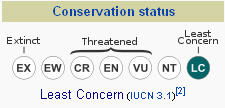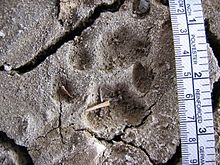Bobcat (Lynx rufus)
The most common wildcat in North America, the bobcat is named for its short, bobbed tail. They are medium-sized cats and are slightly smaller, but similar in appearance, to their cousin, the lynx. Their coats vary in color from shades of beige to brown fur with spotted or lined markings in dark brown or black.
Size
- Height: 17-23 inches
- Length: 24-41 inches
- Weight: 16-28 lbs (males); 10-18 lbs (females)
Lifespan
- Six or eight years of age, with a few reaching beyond ten.
- Up to 30 years in captivity
Reproduction
- Mating Season: winter, but throughout the year is possible
- Gestation: 50-70 days, kittens are usually born around early spring
- Litter Size: 1-6 kittens
- Kitten Rearing: The kittens begin eating solid food at around two months and begin learning to hunt at 5 months. When they are between 8-11 months, the kittens are evicted from their mother’s territory.
Range
Diet
Behavior/Habitat
Bobcat habitat varies widely from forests and mountainous areas to semi-deserts and brush land. A habitat dense with vegetation and lots of prey is ideal. Bobcats are excellent hunters, stalking prey with stealth and patience, then capturing their meals with one great leap. Usually solitary and territorial animals, females never share territory with each other. Male territories, however, tend to overlap. Territories are established with scent markings, and territory sizes are extremely varied-generally 25-30 square miles for males and about five square miles for females.


Population/Status
Approximately 725,000 to 1,020,000 bobcats remain in the wild.
Mexican Bobcat: (Lynx rufus escuinapae)
Click here for the remaining subspecies:
US Fish & Wildlife: Endangered CITES: Appendix I
IUCN: Least Concern CITES: Appendix II
Threats
In Mexico, bobcats are persecuted as sheep predators and are frequently killed by farmers. They are still hunted and trapped for their fur throughout most of their range. Habitat destruction and the ever-expanding human population limit their ranges.
Primary Sources: Defenders of Wildlife and Biogeography of Bobcat
Interesting Facts
- Each bobcat may have several dens in his/her territory, one main den and several auxiliary dens.
- Bobcats look very similar to its cousin the Canada lynx although it is much smaller in size.
- Bobcats are excellent climbers.
- Bobcats swivel their ears to help them pinpoint a sound. The small tufts on the tip of their ears may enhance their hearing.
- Bobcats have few natural enemies.
- 12 bobcat subspecies are currently recognized.
- The bobcat is crepuscular. It keeps on the move from three hours before sunset until about midnight, and then again from before dawn until three hours after sunrise.
- Like all cats, the bobcat directly registers, meaning its hind prints usually fall exactly on top of its fore prints.
The world does not pay for what a person knows. But it pays for what a person does with what he knows.
~Laurence Lee

Primary Sources:
Defenders of Wildlife and Biogeography of Bobcat






